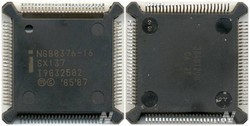
Speed:
Manuf. technology:
Memory address space:
Floating-point arithmetic unit:
Data bus width:
Vcc:
Operating temperature:
16 MHz
CHMOS IV
16 MB
80387SX
8-, 16-, 32-Bit
5 V
0-115 °C
INTEL 80376
| n.n. | Model | Package | Additional description |
| A80376-16 | CPGA-68 | ||
| 1 | NG80376-16, SX137 | PQFP-100 | I9032502; ©'85'87 |
 |
||||||||
| 1 | ||||||||
|
Speed: |
16 MHz |
|||||||
DIFFERENCES BETWEEN THE 80376 AND THE 80386
The following are the major differences between the 80376 and the 80386.
1. The 80376 generates byte selects on BHE and BLE (like the 8086 and 80286
microprocessors) to distinguish the upper and lower bytes on its 16-bit data bus.
The 80386 uses four-byte selects, BE0±BE3, to distinguish between the different
bytes on its 32-bit bus.
2. The 80376 has no bus sizing option. The 80386 can select between either a
32-bit bus or a 16-bit bus by use of the BS16 input. The 80376 has a 16-bit bus
size.
3. The NA pin operation in the 80376 is identical to that of the NA pin on the
80386 with one exception: the NA pin of the 80386 cannot be activated on 16-bit
bus cycles (where BS16 is LOW in the
80386 case), whereas NA can be activated on any 80376 bus cycle.
4. The contents of all 80376 registers at reset are identical to the contents of
the 80386 registers at reset, except the DX register. The DX register contains a
component-stepping identifier at reset, i.e. in 80386, after reset DH e 03H
indicates 80386 DL e revision number; in 80376, after reset DH e 33H indicates
80376 DL e revision number.
5. The 80386 uses A31 and M/IO as a select for numerics coprocessor. The 80376
uses the A23 and M/IO to select its numerics coprocessor.
6. The 80386 prefetch unit fetches code in fourbyte units. The 80376 prefetch
unit reads two bytes as one unit (like the 80286 microprocessor). In BS16 mode,
the 80386 takes two consecutive bus cycles to complete a prefetch request. If
there is a data read or write request after the prefetch starts, the 80386 will
fetch all four bytes before addressing the new request.
7. The 80376 has no paging mechanism.
8. The 80376 starts executing code in what corresponds to the 80386 protected
mode. The 80386 starts execution in real mode, which is then used to enter
protected mode.
9. The 80386 has a virtual-86 mode that allows the execution of a real mode 8086
program as a task in protected mode. The 80376 has no virtual-86 mode.
10. The 80386 maps a 48-bit logical address into a 32-bit physical address by
segmentation and paging. The 80376 maps its 48-bit logical address into a 24-bit
physical address by segmentation only.
11. The 80376 uses the 80387SX numerics coprocessor for floating point
operations, while the 80386 uses the 80387 coprocessor.
12. The 80386 can execute from 16-bit code segments. The 80376 can only execute
from 32-bit code Segments.
13. The 80376 has an input called FLT which three-states all bidirectional and
output pins, including HLDA, when asserted. It is used with ON Circuit Emulation
(ONCE).